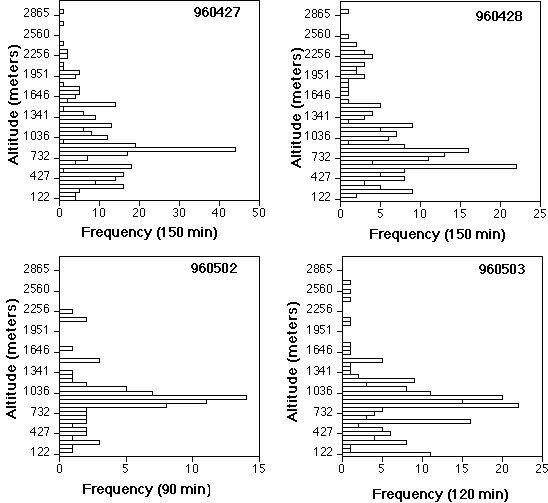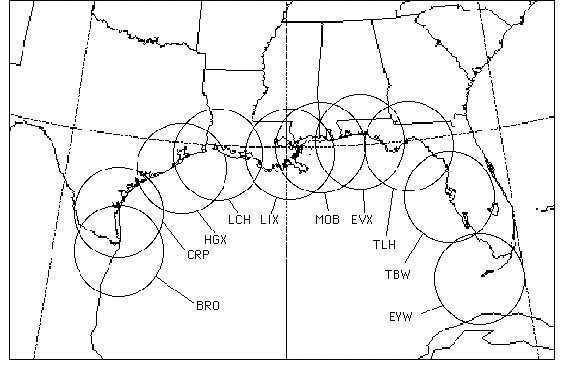
S33.1: Bird migration in the region of the Gulf of Mexico
Sidney A. Gauthreaux, Jr. & Carroll G. Belser
Department of Biological Science, Clemson University, Clemson, South Carolina 29634-1903, USA, fax 864 656 0435 , e-mail sagth@clemson.edu
Gauthreaux, S.A., Jr. & Belser, C.G. 1999. Bird migration in the region of the Gulf of Mexico. In: Adams, N.J. & Slotow, R.H. (eds) Proc. 22 Int. Ornithol. Congr., Durban:
1931-1947. Johannesburg: BirdLife South Africa.Since the turn of the century considerable debate has surrounded the flight strategies of migratory birds in the vicinity of the Gulf of Mexico. Cooke (1904) and Lowery (1945) suggested that many species fly across the Gulf in spring. In contrast, Williams (1945) proposed that most birds migrated around the Gulf. Lowery (1946, 1951) subsequently documented the evening departure of migrants from Yucatan, Mexico. Since the mid-1960s radar studies of bird migration along the northern Gulf coast show that trans-Gulf migration occurs regularly from mid-March to late-May. The timing and point of arrival of each trans-Gulf migration is strongly dependent on atmospheric steering currents and weather over the Gulf. Since 1992 the use of new doppler weather surveillance radars on the northern Gulf coast has facilitated the study of flight speeds and directions of migrants in the Gulf of Mexico region. Data from these radars show that in spring circum-Gulf migrants may fly NE from the coasts of Brownsville, TX and Tamaulipas, Mexico, cross the northwestern Gulf, and make landfall on the upper Texas and southwestern Louisiana coast when winds are favourable for such a flight. In the fall, migrants occasionally depart southward from the northern Gulf coast, turn WSW offshore, and make landfall on the lower Texas coast. These flights, like those in spring, are strongly dependent on wind patterns over the Gulf.
INTRODUCTION
The Gulf of Mexico is a formidable water barrier positioned between the breeding grounds of many migratory species in eastern and central North America and their nonbreeding-overwintering areas in Central and South America. The topic of migrants crossing the Gulf in spring and fall has been debated heatedly since the turn of the century, and as a result trans-Gulf migration has been thoroughly studied by ornithologists. The lessons learned form these investigations illustrate how science works and how sometimes both sides of a debate can be correct!
METHODSThe methods used to study bird migration in the region of the Gulf of Mexico have been diverse. Early studies of migration (e.g., Cooke 1904) relied on field records of observers and data from museum specimens, and even today field observations continue to yield important information. Bird-banding with mist nets at coastal stations is also providing data on species composition as well as physiological condition of trans-Gulf migrants (e.g., Moore et al. 1990). Moon-watching (Lowery 1951) has been employed not only to document patterns of trans-Gulf migration (e.g., Lowery 1946), but it has also been a useful tool for quantifying radar displays of nocturnal migration through and from coastal areas (Gauthreaux 1970). Daytime observations with vertically pointing 20x or 30 x telescopes (Newman & Lowery 1966) or high-magnification binoculars have been used to study the spring arrival of trans-Gulf migrants on the northern Gulf coast and their fall arrival on the coast of Yucatan, but all visual techniques are dependent on ideal viewing conditions, and such conditions can be rare. Since 1965 in an effort to overcome the shortcomings of telescopic studies of migration, weather surveillance radar (WSR-57 and more recently WSR-88D) has been used to detect, quantify, and monitor the spring arrival and fall departure of trans-Gulf flights on the northern Gulf coast. The WSR-88D is a doppler radar that is more sensitive, more powerful, and has greater resolution than the older WSR-57 weather surveillance radars. Details of these radars can be found in Gauthreaux (1970) for the WSR-57 and Gauthreaux and Belser (1998) for the WSR-88D. Because the 1°-2° beam widths of weather surveillance radars result in rather poor vertical resolution, fixed vertical-beam marine radar has been used to measure more accurately the altitudinal distribution of migrants as they arrive on the northern Gulf coast (Gauthreaux, unpublished data). The migration pathways of several raptor species in the region of the Gulf of Mexico have been mapped with the aid of satellite radio telemetry (Argos platform) (e.g., Fuller et al. 1995; Seegar et al. 1996). Because of the problems associated with statistical analysis of periodic data (e.g., date, time) we have employed the convention of Julian date and hours past 00:00 hours UTC (GMT). Julian date begins 1 January and counts forward to 365 for 31 December in non-leap years and to 366 in leap years. Thus 1 March is Julian date 60, 1 April is 91, 1 May is 121, and 1 June is 152.
RESULTS Historical BackgroundThe topic of migrants crossing the Gulf of Mexico in spring and fall has been of interest to students of bird migration since the analyses of Cooke (1904, 1915). He suggested that many different species of birds cross the Gulf in spring and that the scarcity of some species on the immediate coast is the result of birds not landing but continuing some distance inland after crossing the Gulf. G. C. Williams (1945) questioned these hypotheses and insisted that many of the species observed over the northern Gulf of Mexico in spring are blown there as they migrate circum-Gulf up from Mexico and Florida. His alternative hypothesis appeared to be supported by the dearth of Neotropical migrants on the immediate northern coast of the Gulf of Mexico reported by many observers. Lowery (1945) reaffirmed Cooke’s original hypothesis that during fine flying weather (clear to partly cloudy skies and a good wind from the south) trans-Gulf migrants do not typically land in the first available habitat but continue for some miles inland before landing. Moreover the timetable of trans-Gulf migration is such that early morning is the worst time to census trans-Gulf migrants in stopover areas along the coast.
Lowery (1946) addressed the points made by Williams (1945) and carefully re-examined the evidence Williams used in support of the notion that all migration northward in spring from the tropics was circum-Gulf rather than trans-Gulf. Lowery (1946) presented important new data in support of the existence of spring trans-Gulf migration. He used a moon-watching technique that enabled him to see the silhouettes of migrating birds as they passed before the disc of the full moon. By moon-watching at Progresso, Yucatan in the spring of 1945 he was able to record migrating birds heading northward out over the Gulf of Mexico. In the eyes of the ornithological community, Lowery’s second paper firmly re-established the conviction that many and perhaps most of the migrants that breed in the eastern two-thirds of North American and winter in Central and South America reach their destinations in spring after flying directly across the Gulf of Mexico. Stevenson (1957) examined the species composition of trans-Gulf and circum-Gulf migration and presented evidence (direct observation, comparative abundance, and sequence of arrival dates) favouring each of the two migration routes for 164 species. Although there is clear evidence that some Neotropical migrants fly circum-Gulf in their spring migration, 40 species are certainly trans-Gulf migrants as they are most common on the northern Gulf coast and not on the western and eastern Gulf coasts.
Since the pioneering studies of trans-Gulf migration by George Lowery and Robert Newman at Louisiana State University studies of the patterns of trans-Gulf migration using moon-watching, vertical telescope, and censuses of birds at stopover sites have continued. The use of weather surveillance radars along the northern Gulf coast to detect, monitor, and quantify arriving trans-Gulf flights in spring began in the mid 1960s (Gauthreaux 1970) and continues today (Gauthreaux and Belser 1998, Fig. 1). The establishment of banding sites and studies of migrant bird-habitat associations at isolated stopover sites in the 1980s (Moore et al.1990) has greatly supplemented knowledge of temporal and spatial patterns.
Daily Timing
The pattern of arrival of trans-Gulf migration displayed on weather surveillance radar is easily recognised and can be discriminated readily from precipitation type echoes (see Gauthreaux 1971 for WSR-57 displays and Gauthreaux and Belser 1998 for WSR-88D displays). The daily timing of arrival of a trans-Gulf flight on the northern Gulf coast is strongly influenced by Julian date and synoptic weather conditions over the Gulf (Gauthreaux 1971). For the upper Texas and southwestern Louisiana coast the arrival of trans-Gulf flights typically begins in the morning hours with moderate winds from the south (5-10 ms-1 about 11-22 mph at altitudes from 767 m through 1489 m), peaks in the afternoon, and is essentially finished by nightfall (Fig. 2). The peak arrival time occurs later as the spring season progresses and earlier at coastal stations farther south ( Fig. 3 and Fig. 4). The peak arrival time of a flight is strongly correlated with the velocity of winds aloft (Fig. 5).
Most of the flocks of trans-Gulf migrants general fly over the coast and make landfall in the bottomland forests inland from the coast . During very favourable flying conditions (strong southerly winds aloft and fair weather) the migrants may fly far inland, and only during adverse weather (hard rain or strong north winds) do substantial numbers put down in coastal woodlands (Gauthreaux 1971). Most of the birds that put down on offshore oil rigs and in coastal woodlands when flying conditions are good are probably physiologically stressed (Spengler et al. 1995. Leberg et al. 1996).
Thirty to 40 minutes after sunset (during nautical twilight), most of the migrants that landed during the daytime arrival of a flight depart the stopover areas and begin another leg of their migratory journey. This exodus is often spectacular on radar as the density of migrants flying singly aloft increases rapidly (see figures in Gauthreaux and Belser 1998 and Fig. 6). The duration of the exodus rarely exceeds three hours for radar stations on the central northern Gulf coast (from Lake Charles LA eastward to northwestern Florida), but for stations along the Texas coast, the movement of migrants toward the N and NE continues for most of the night. These movements contain not only birds that arrived from over the Gulf earlier in the day but also migrants moving up from eastern Mexico (Forsyth and James 1971).
Seasonal Timing
Spring trans-Gulf migration begins typically in the first and second week of March, peaks in late April and early May, and is greatly reduced by the third week in May (Fig. 7, Fig. 8 and Fig. 9). The amount of data in each diagram of Fig. 7, Fig. 8 and Fig. 9 reflects how the arrival of trans-Gulf migration is biased in general toward the northwestern Gulf coast. This is in keeping with the average synoptic pattern over the Gulf of Mexico is spring (Gauthreaux 1971, 1991; Buskirk 1980). Only very small flights continue to cross the Gulf until the end of May and the first week of June (Gauthreaux 1971 and unpublished data). The patterns of winds aloft over the Gulf of Mexico are critically important to the seasonal timing of trans-Gulf migration. In March the winds over the Gulf are influenced often by continental polar air masses (anticyclonic systems over southeastern United States) and winds blow from the East near the surface and aloft. Only when southerly return flow of maritime tropical air occurs are conditions good for a south-to-north trans-Gulf crossing, and this occurs aloft before it occurs on the surface (Gauthreaux 1971, 1991). Consequently winds aloft are generally more favourable for a Gulf crossing than are surface winds. As spring progresses the number of days with good return flow increases. In April and May the favourableness of the pattern of winds aloft increases as cold fronts typically decrease in frequency (Gauthreaux 1971, 1991; Buskirk 1980; Duncan 1994). When powerful cold fronts move southward over the Gulf in late April and early May, spectacular fallouts or downings of migrants often take place on offshore oil rigs, fishing boats in the northern Gulf, and in coastal woodlands. The birds are often exhausted, without fat reserves, and often show evidence of having catabolized breast muscle (the keel of the sternum is like a knife blade) (Gauthreaux, unpublished observations). Many of these migrants do not survive. When cold fronts are weak and shallow, most trans-Gulf migrants continue flying north in southerly air flow above the frontal boundary (Gauthreaux 1972, 1991).
With the establishment of 10 WSR-88D radars along the northern Gulf coast, it is now possible to monitor patterns of bird migration within 200 km of any station. In spring the nightly exodus of migrants from Cuba can be readily monitored by the Key West, FL radar (Fig. 9), and it is very apparent that the Gulf coast of Florida (other than the northwestern coast) rarely receives trans-Gulf migrations. Only when steering wind currents over the Gulf direct the flight toward the east and northeast do numbers of migrants make landfall on the western coast of Florida. The western Gulf radars have revealed trans-Gulf flights in spring that originate on the Gulf coast of Tamaulipas and south Texas and move northeastward out over the Gulf and make landfall on the upper Texas and southwestern Louisiana coast. The movements are not common and occur when winds ahead of a slow moving cold fronts are from the southwest.
Altitudinal Distribution of Migrants
The altitude of trans-Gulf migration as it arrives on the northern coast of the Gulf is considerably higher than that for most migratory movements of songbirds over land during daylight hours (Gauthreaux 1971,1972, 1991). Fig. 10 shows simple frequencies of counted echoes per altitude as measured by a 5 kw fixed vertical-beam (FVB) radar on the Gulf coast south of Lake Charles, LA, in the spring of 1996. The distribution of altitudes agrees with measurements made simultaneously with WSR-88D radar. The altitudes are also in keeping with those measured previously using WSR-57 radar (Gauthreaux 1972) and a 10 kw FVB radar (Gauthreaux 1991). Echoes from insects are occasionally a problem at altitudes up to 500 m during daytime arrivals of trans-Gulf flights. However, one can determine easily when this is occurring, because incoming trans-Gulf migrants flying below 500 m can be easily seen overhead with the aid of 10x binoculars. In most instances the thickness of the layer of trans-Gulf migrants aloft is on the order of 1500 to 2000 m and the altitudinal distribution of individuals and flocks typically ranges from 400 to 3000 m. The altitudinal distribution is strongly dependent on winds aloft (Gauthreaux 1991). If the most favourable southerly flows are at low altitudes, then the distribution of trans-Gulf migrants is skewed to lower altitudes. If the most favourable southerly winds are at higher altitudes, then the migrants will fly at those altitudes. In one instance trans-Gulf migrants were flying at altitudes of 3657-4572 meters (12,000- 15,000 ft) as they moved inland above a shallow cold front that had penetrated the northern Gulf (Gauthreaux 1991). When powerful cold fronts move well into the Gulf and trans-Gulf migrants cannot fly over the altitudinal zone of adverse winds, they lower their flight altitude and fly just above the waters of the Gulf (Gauthreaux 1971 and unpublished observations). On such occasions migrants can be seen arriving on the northern Gulf coast just above the water and below the coverage of weather surveillance radar. Even though arriving low-altitude flights go undetected by radar, the magnitude of the subsequent exodus from coastal stopover areas is easily seen on radar and can be used to document such arrivals. Once over land trans-Gulf migrants do not fly against strong northerly winds (Gauthreaux 1971 and unpublished data).
DISCUSSION
Conclusions for Spring Migration
The migration patterns in spring in relation to the northern coast of the Gulf of Mexico are now reasonably well know. The network of 10 WSR-88D weather radars from Brownsville, TX to Key West, FL have recently provided detailed information on the temporal and spatial patterns of trans- and circum-Gulf migration. The timing of Gulf crossings is clearly related to time of departure from south of the Gulf and weather conditions during the crossing. Under normal circumstances (southerly winds aloft and fair conditions) the flights arrive during daylight hours on the northern Gulf coast. When winds over the Gulf are not southerly (northerly, easterly or westerly) the flights are delayed, or displaced, or both. The data on the spatial extent of trans-Gulf flights suggest a fairly broad front movement. It is not unusual to have trans-Gulf migration arriving over approximately one third of the 2250 km coastline from Brownsville, TX to Key West, FL. The altitude of arriving flights is dependent on the pattern of winds aloft (Gauthreaux 1991) and the fact that birds progressively climb as fuel is used up and speed reduced (Pennycuick 1978). Although much is known about the arrival of trans-Gulf flights on the northern Gulf coast, the same cannot be said for the southern Gulf coast. Other than Lowery’s pioneering studies no additional studies have examined the departure phase of trans-Gulf flights from Mexico and western Cuba.
Conclusions on Autumn Migration
Although this presentation and most of the published literature on trans-Gulf migration has emphasised spring migration, relatively little has been written on fall migration studies along the northern Gulf coast and over the northern Gulf. Lowery and Newman (1966) suggested on the basis of their analysis of four nights of migration in October that a sizeable proportion of migrants may detour the Gulf in fall and move westward and southwestward. An analysis of data gathered on 34 nights during fall, 1969, at Lake Charles, in southwestern Louisiana by Able (1972) demonstrated that weather conditions over the Gulf of Mexico in fall are not favourable for trans-Gulf migration. The frequency of cold fronts that could assist a crossing is quite low until late in the season. Able (1972) found a strong net flow of songbirds toward a southwesterly direction assisted by prevailing northeasterly winds and disproportionately large migrations associated with winds flowing towards wintering grounds. Other than brief reports (Paynter 1953; Siebenaler, 1954) only one comprehensive study of the arrival of trans-Gulf migration on the southern Gulf coast has been published (Buskirk 1980). He found that high magnitude trans-Gulf migrations occur under post cold front conditions with most migrants crossing in late September and the first three weeks of October. However, northerly winds over the northern Gulf coast occur on approximately 10 percent of September and 25-30 percent of October dates. Only in early and late November does the frequency of northerly flow over the Gulf increase to 39 and 51 percent of the dates.
Preliminary findings using a network of WSR-88D radars on the northern Gulf coast since the fall of 1995 suggest that the pattern of trans-Gulf migration in the fall is very different from that in the spring. Because of the prevailing southerly wind patterns over the Gulf in fall, trans-Gulf flights are closely associated with frontal systems that penetrate the northern Gulf and move well into the Gulf. The frequency of these fronts is low during most of the fall when Neotropical migrants are moving toward their wintering grounds. Consequently many of the flights from the northern Gulf coast following weak cold fronts appear to be directed toward the SW, a direction that takes the migrants to the south Texas and upper Mexican coast. In the absence of cold fronts the migrants appear to follow the Texas coast and also move down the peninsula of Florida as Able (1972) has detailed. Although little has been published about migratory birds on offshore oil production platforms in the Gulf in fall, Ortego's (1977) observations suggest that much can be learned by sampling these structures during fall migration.
ACKNOWLEDGEMENTSThis manuscript was prepared and presented with support from the Legacy Resource Management Program of the United States Department of Defense. We also wish to acknowledge the continuing assistance of the personnel of the National Weather Service, United States Department of Commerce. The personnel at the NWS stations along the northern Gulf coast have always been cooperative and friendly. They have allowed access to WSR-57 and WSR-88D radars and weather data and made our work possible. We also thank David S. Mizrahi and Jenny E. Michi for their help with the preparation of the manuscript. Bruno Bruderer made several helpful suggestions that greatly improved the manuscript.
REFERENCES Able, K.P. 1972. Fall migration in coastal Louisiana and the evolution of migration patterns in the Gulf region. Wilson Bulletin 84: 231-242.Buskirk, W.H. 1980. Influence of meteorological patterns and trans-Gulf migration on the calendars of latitudinal migrants. In: Keast, A. & Morton, E. (eds) Migrant Birds in the Neotropics: Ecology, Behavior , Distribution, and Conservation. Smithsonian Institution Press: 485-491.
Cooke, W.W. 1904. Some new facts about the migration of birds. Yearbook of Department of Agriculture for 1903. Govt. Printing Office, Washington, DC: 371-386.
Cooke, W.W. 1915. Bird migration. U.S. Dept. Agriculture Bulletin. No. 185.
Duncan, R.A. 1994. Bird migration weather and fallout: Including the migrant traps of Alabama and northwest Florida. Edited and published by Robert A. Duncan, 614 Fairpoint Dr., Gulf Breeze, FL 32561.
Forsyth, B.J. & James D. 1971. Springtime movements of transient nocturnally migrating landbirds in the Gulf coastal bend region of Texas. Condor 73: 193-207.
Fuller, M.R, Seegar W.S. & Howey P.W. 1995. The use of satellite systems for the study of bird migration. Israel Journal of Zoology 41: 243-252.
Gauthreaux, S.A., Jr. 1970. Weather radar quantification of bird migration. BioScience 20: 17-20.
Gauthreaux, S.A., Jr. 1971. A radar and direct visual study of passerine spring migration in southern Louisiana. Auk 88: 343-365.
Gauthreaux, S.A., Jr. 1972. Behavioral responses of migrating birds to daylight and darkness: A radar and direct visual study. Wilson Bulletin. 84: 136-148.
Gauthreaux, S.A., Jr. 1991. The flight behavior of migrating birds in changing wind fields: Radar and visual analyses. American Zoologist 31: 187-204.
Gauthreaux, S.A., Jr. & Belser C.G. 1998. Displays of bird movements on the WSR-88D: Patterns and quantification. Weather and Forecasting 13: 453-464.
Leberg, P.L., Spengler T.J. & Barrow W.C., Jr. 1996. Lipid and water depletion in migrating passerines following passage over the Gulf of Mexico. Oecologia 106: 1-7.
Lowery, G.H., Jr. 1945. Trans-Gulf spring migration of birds and the coastal hiatus. Wilson Bulletin 57: 92-121.
Lowery, G.H., Jr. 1946. Evidence of trans-Gulf migration. Auk 63: 175-211.
Lowery, G.H., Jr. 1951. A quantitative study of the nocturnal migration of birds. University of Kansas Publications, Museum of Natural History, June 1951, Volume 3.
Lowery, G.H., Jr. & Newman R.J. 1963. Studying bird migration with a telescope. Special Publication. Museum of Zoology, Louisisana State Univ., Baton Rouge, LA.
Lowery, G.H., Jr. & Newman R.J. 1966. A continentwide view of bird migration on four nights in October. Auk 83: 547-86.
Moore, F.R., Kerlinger P. & Simons T.R. 1990. Stopover on a Gulf coast barrier island by spring trans-Gulf migrants. Wilson Bulletin 102: 487-500.
Ortego, B. 1977. Birding on an oil production platform. Louisiana. Ornithological. Society. Newsletter 78: 8-9.
Paynter, R.A. 1953. Autumnal migrants on the Campeche Bank, Auk 70: 338-349.
Pennycuick, C.J. 1978. Fifteen testable predictions about bird flight. Oikos 30: 165-176.
Seeger, W.S., Cutchis P.N., Fuller M.R., Suter J.J., Bhatnagar V. & Wall J.S. 1996. Fifteen years of satellite tracking development and application to wildlife research and conservation. Johns Hopkins Applied Physics Laboratory Technical Digest, 17: 305-315.
Siebenaler, J.B. 1954. Notes on autumnal trans-Gulf migration of birds. Condor 56: 43-48
Spengler, T.J., Leberg P.L. & Barrow W.C., Jr. 1995. Comparison of condition indices in migratory passerines at a stopover site in coastal Louisiana. Condor 97: 438-444.
Stevenson, H.M. 1957. The relative magnitude of the trans-Gulf and circum-Gulf spring migrations. Wilson Bulletin 69: 39-77.
Williams, G.G. 1945. Do birds cross the Gulf of Mexico in spring? Auk 62: 98-11.
Fig. 1. Map of the locations of the WSR-88D radars along the northern coast of the Gulf of Mexico. Each circle has a radius of 230 km–the point at which the center of the 0.95° beam elevated 0.5° is at an altitude of 3 km.

Fig. 2. Daily temporal pattern of trans-Gulf migration arrival and the subsequent exodus of migrants from stopover areas on 26-27 April 1998. The data are from base reflectivity images from the Brownsville, TX (BRO), Corpus Christi, TX (CRP), Houston, TX (HGX) and Lake Charles, LA (LCH) WSR-88D radars. The times are expressed in hours after 00:00 UTC. The pixel reflectivity value (PRV) is the sum of dBZ values of all pixels in a 25 x 25 pixel square corrected by multiplicative factors (e.g., a 20 dBZ difference equals a factor of 100).
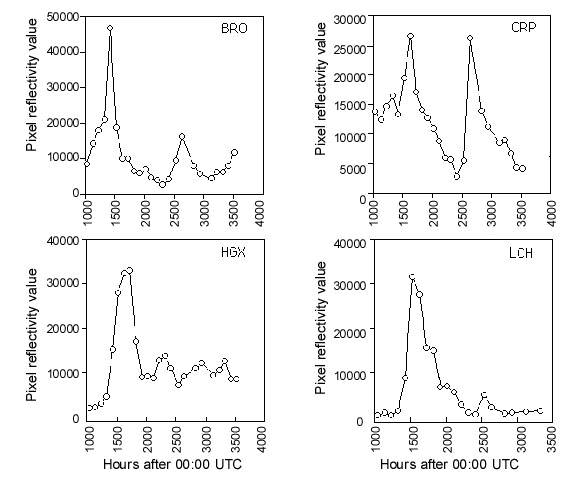
Fig. 3. Time of peak arrival of trans-Gulf migration as a function of seasonal date; the single graphs arranged according to latitude of radar station. The data are for the spring of 1998 and were taken from 2 km x 2 km mosaic images of WSR-88D station data from Brownsville, TX (BRO); Corpus Christi, TX (CRP); Houston, TX (HGX); Lake Charles, LA (LCH). The slope of the regression line at LCH reflects not only a one hour change in time of sunset from Julian date 60 (1 March) through Julian date 151 (31 May), but also variation in winds aloft over the Gulf.
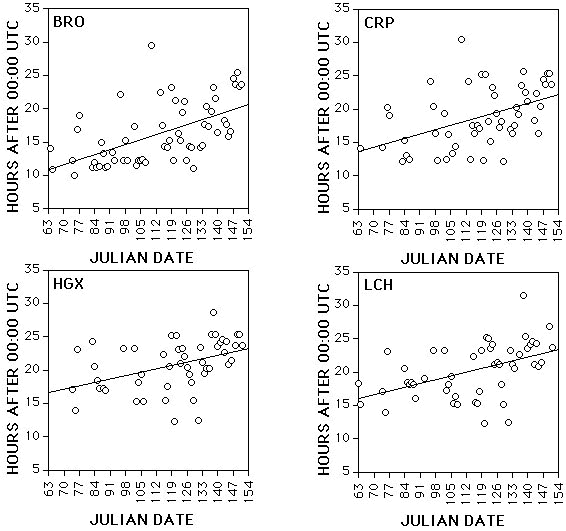
Fig. 4. Time of peak arrival of trans-Gulf migration as a function of seasonal date; the single graphs arranged according to latitude of radar station. The data are for the spring of 1998 and were taken from 2 km x 2 km mosaic images of WSR-88D station data from Slidell, LA (LIX); Mobile, AL (MOB); Tamapa, FL (TBW) and Key West, FL (EYW). Julian date 60 is 1 March, 91 is 1 April, 121 is 1 May, and 152 is 1 June.
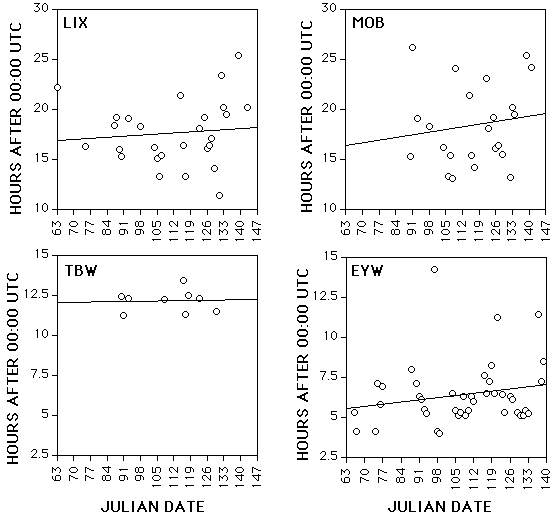
Fig. 5. Influence of wind speeds on the time of trans-Gulf migration arrival on the northern Gulf coast. The 850 mb (1489 m) winds were from Lake Charles, LA (LCH) at 1200 UTC from 1 March through 31 May 1998.
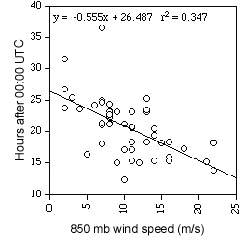
Fig. 6.. Nocturnal exodus of trans-Gulf migrants from coastal stopover areas. Note the sudden increase in velocity and change in direction of the wind flags at 0115 UTC at Lake Charles, LA (LCH) on 16 April 1997. A full barb on the wind flag equals 5.1 ms-1 and a half barb equals 2.3 ms-1. The changes are the result of the WSR-88D detecting birds as they climb into the radar beam at the time of exodus. The altitudinal distribution of the migrant swarm is also clearly evident.
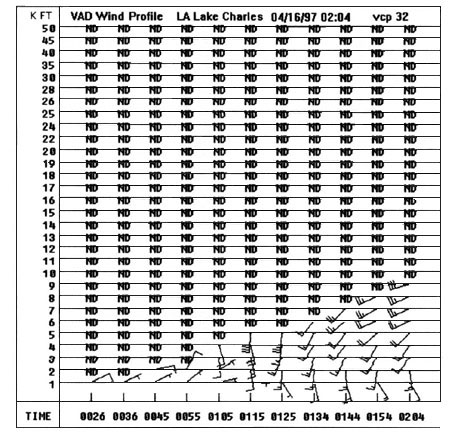
Fig. 7. The seasonal temporal pattern of trans-Gulf migration at Brownsville, TX (BRO); Corpus Christi, TX (CRP); Houston, TX (HGX); and Lake Charles, LA (LCH). Each plot shows the maximum base reflectivity in dBZ at peak arrival of trans-Gulf flights for each WSR-88D station.
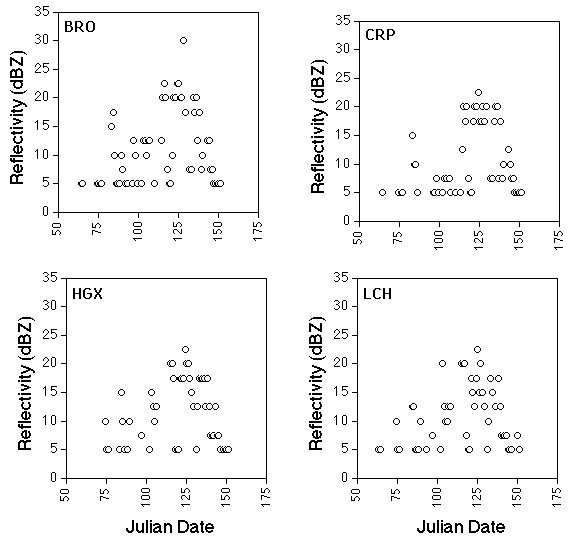
Fig. 8. The seasonal temporal pattern of trans-Gulf migration at Slidell, LA (LIX); Mobile, AL (MOB); Eglin Air Force Base, FL (EVX); and Tallahassee, FL (TLH). Each plot shows the maximum base reflectivity in dBZ at peak arrival of trans-Gulf flights for each WSR-88D station.
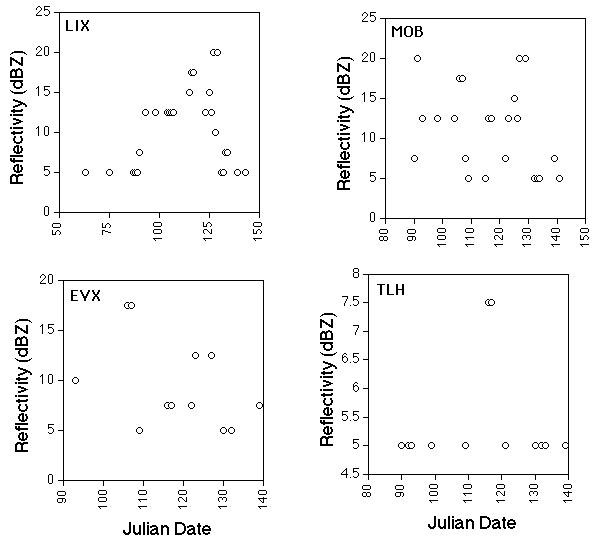
Fig. 9. The seasonal temporal pattern of trans-Gulf migration at Tamapa, FL (TBW) and Key West, FL (EYW). Each plot shows the maximum base reflectivity in dBZ at peak arrival of trans-Gulf flights for each WSR-88D station.
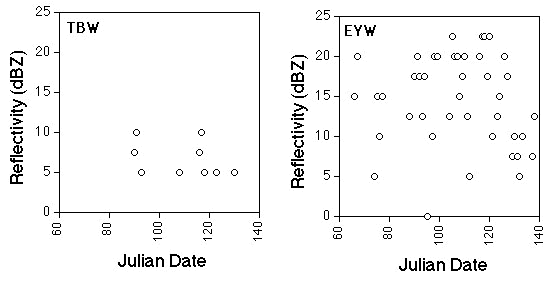
Fig. 10. The altitude of arriving trans-Gulf migrants as measured by vertical fixed-beam radar on the coast of southwestern Louisiana, 1996. The data were gathered during 30 min periods and have been summed by date in each diagram. Note the effects of low-altitude insect contamination on 3 May 1996.
